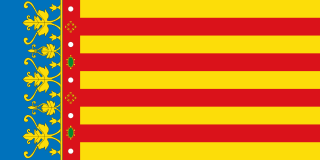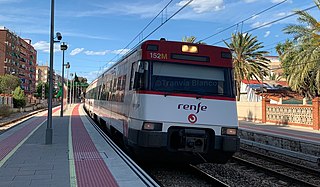
Abdon and Sennen, variously written in early calendars and martyrologies Abdo, Abdus, and Sennes, Sennis, Zennen, are recognized by the Catholic Church and Eastern Orthodox Church as Christian martyrs, with a feast day on 30 July. In some places they have been honoured on 20 March, and the first Sunday of May.

The Albufera de València, is a freshwater lagoon and estuary on the Gulf of Valencia coast of the Valencian Community in eastern Spain. It is the main portion of the Parc Natural de l'Albufera de València, with a surface area of 21,120 hectares. The natural biodiversity of the nature reserve allows a great variety of flora and fauna to thrive and be observed year-round. Though once a saltwater lagoon, dilution due to irrigation and canals draining into the estuary and the sand bars increasing in size had converted it to freshwater by the seventeenth century.

The Júcar or Xúquer is a river in Spain, on the Iberian Peninsula. The river runs for approximately 509 km.

Cullera is a city and municipality of Spain located in the Valencian Community. It is part of the province of Valencia and the Ribera Baixa comarca. The city is situated near the discharge of the river Júcar in the Mediterranean Sea.

Ribera Baixa is a comarca in the province of Valencia, Valencian Community, Spain.

The Autovía A-38 is a motorway in the Valencian Community, Spain.

Simat de la Valldigna is a municipality in the comarca of Safor in the Valencian Community, Spain. It is 50 km from Valencia, and 20 km from Cullera and Gandia. It is also near Xàtiva and Alzira.

The Corts Valencianes, commonly known as Les Corts, are the main legislative body of the Generalitat Valenciana and therefore of the Valencian Community. The main location of the Corts is in the Palace of the Borgias in Valencia; however it can meet at any location in the Valencian lands. The Corts has its origins in bodies established in the thirteenth century by King James I of Aragon. The modern institution was established in 1982 under the Valencian statute of autonomy of 1982. The current Corts were elected in 2023.

The Valencian Community is an autonomous community of Spain. It is the fourth most populous Spanish autonomous community after Andalusia, Catalonia and the Community of Madrid with more than five million inhabitants. Its homonymous capital Valencia is the third largest city and metropolitan area in Spain. It is located along the Mediterranean coast on the east side of the Iberian Peninsula. It borders Catalonia to the north, Aragon and Castilla–La Mancha to the west, and Murcia to the south, and the Balearic Islands are to its east. The Valencian Community is divided into three provinces: Castellón, Valencia and Alicante.

Josep Lluís Albiñana Olmos is a Spanish judge and former politician in the Spanish Socialist Workers' Party (PSOE).

In Francoist Spain, at least two to three hundred concentration camps operated from 1936 until 1947, some permanent and many others temporary. The network of camps was an instrument of Franco's repression.

The Grup d'Acció Valencianista (GAV) is a blaverist organization which was created in 1977. They define themselves as "the fighting and warlike faction of real valencianism". Nonetheless, they are generally considered as an extreme right group due to their activities.
Many people have been imprisoned, placed on remand, or otherwise kept in custody due to their illegal activity in support of the Basque National Liberation Movement.
The Villas de Salvárcar massacre occurred in Villas de Salvárcar, Ciudad Juárez, Mexico, on January 31, 2010, early in the morning. 16 young people died. Alejandro Martínez-Cabrera of the El Paso Times stated that the event "brought attention to the city's social problems" and "caused outrage in Mexico because of the brutality.". People outside Mexico also expressed outrage about the crime. As a result, the federal government started the program "Todos Somos Juárez" to rejuvenate the city, and President of Mexico Felipe Calderón took additional measures against drug cartels. Lorena Figueroa of the El Paso Times stated that due to the "brutality" of the crime, "the massacre gave notoriety" to Villas de Salvárcar.

Valencian Art Nouveau is the historiographic denomination given to an art and literature movement associated with the Art Nouveau in the Valencian Community, in Spain.

The Montjuïc trial was a trial of anarchist suspects in the military Montjuïc Castle following the 1896 terrorist attack on the Barcelonean Corpus Christi procession. About 400 suspects were arrested, from whom 87 were put on trial and five executed. Stories of forced confessions through torture led to an 1898–1899 campaign for a judicial review of the trial organized through Alejandro Lerroux and his newspaper El Progreso. Republican support for Lerroux from this action led to his rise as a left-wing force in Barcelona.

Torture in Venezuela has been a consistent phenomenon throughout its history. Various dictatorships from the Spanish colonial era into the twentieth century utilized torture against common criminals and political opponents. In the twentieth century, torture was common during the dictatorships of Juan Vicente Gómez and Marcos Pérez Jiménez. Torture also took place occasionally during Venezuela's democratic period, particularly during social outbursts, such as during the Caracazo and the 1992 coup attempts.

The C-1 line of Cercanías Valencia covers 63 km across the province of Valencia, between Valencia Nord and Gandía or Grao de Gandía. It serves the municipalities of Valencia, Alfafar, Benetússer, Massanassa, Catarroja, Silla, Sollana, Sueca, Cullera, Tavernes de la Valldigna, Xeraco, and Gandia.

The Albufera Natural Park or simply La Albufera is a Spanish protected natural area located in the province of Valencia, Valencian Community. It was referred to by the Romans as Nacarum Stagnum, and in some Arabic poems, it is referred to as "Mirror of the Sun".
Esteve Conrad Francesc Pallarols Xirgu was a Catalan anarchist who became the first General Secretary of the CNT in clandestinity after the end of the Spanish Civil War. He organised the release of anarchist prisoners from Francoist concentration camps and their subsequent escape from Spain, for which he was executed by the Francoist authorities.

















